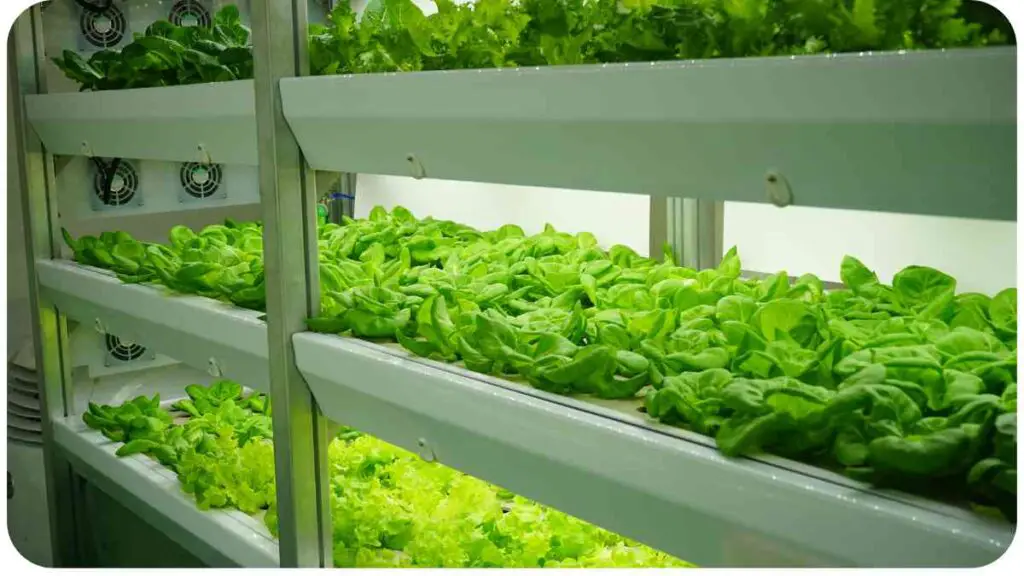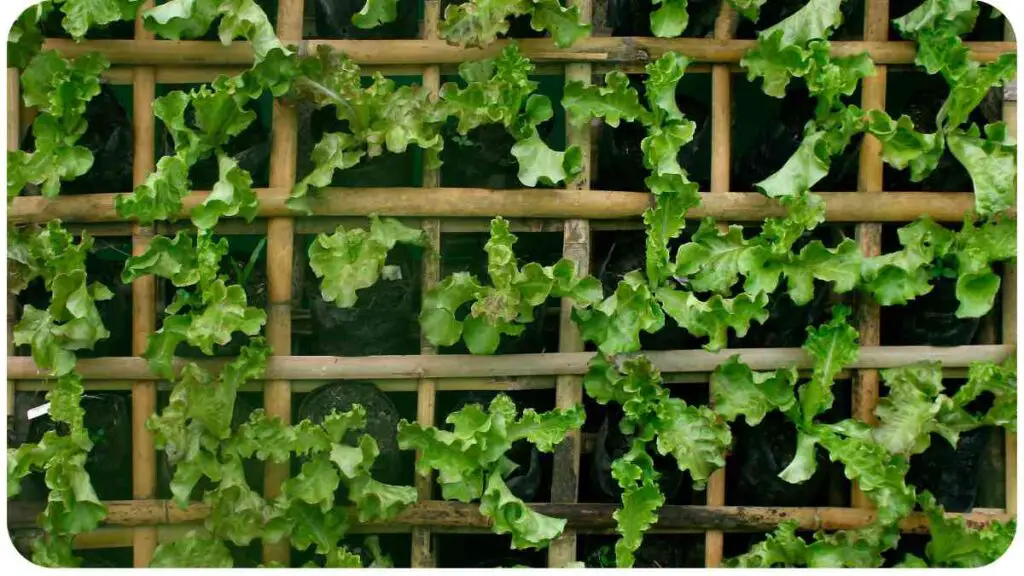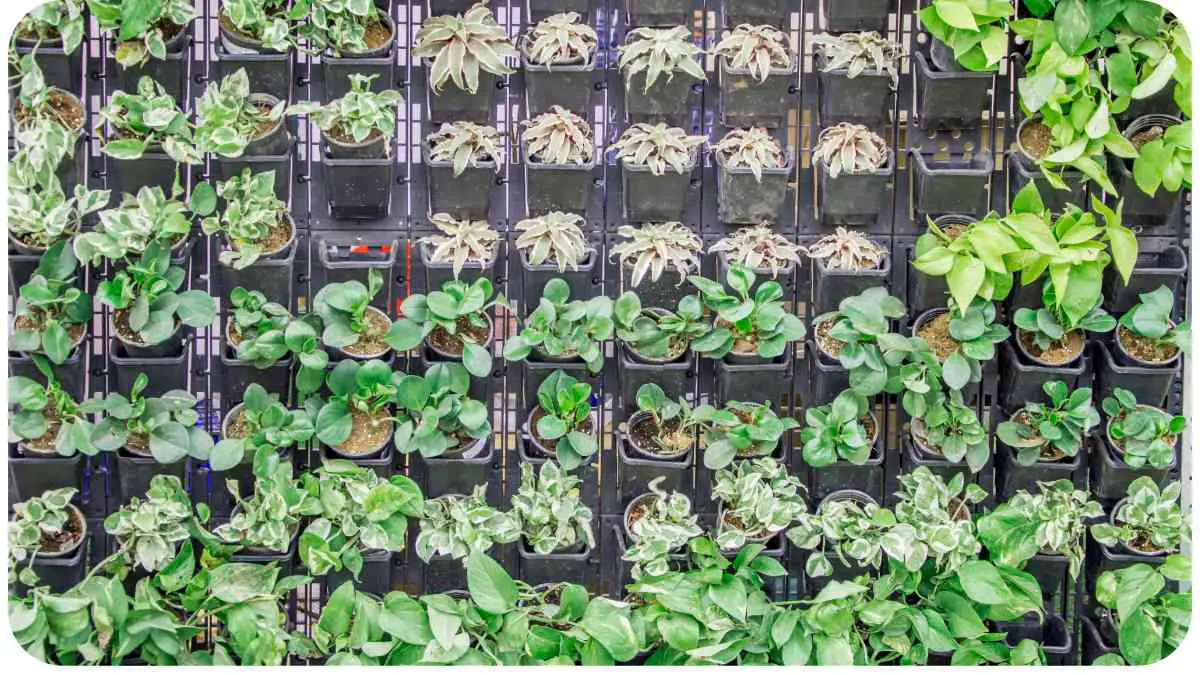Vertical gardening is a revolutionary approach to cultivating plants upward instead of outward, making the most of limited space. As a seasoned urban gardener, I’ve witnessed the transformative power of vertical gardening in maximizing greenery in tight city quarters.
| Takeaways |
|---|
| Vertical gardening maximizes space in urban areas. |
| Aesthetic appeal and accessibility enhance living spaces. |
| Initial setup costs are outweighed by long-term benefits. |
| Strategic plant choices and irrigation ease maintenance. |
| Learn from industry experts for continuous improvement. |
| Embrace creativity and experimentation in vertical gardening. |
Table 1: Comparison of Space Utilization in Vertical vs. Traditional Gardens
| Aspect | Vertical Gardening | Traditional Gardening |
| Square Footage Needed | Less | More |
| Visual Impact | High | Moderate |
| Maintenance Space | Compact | Spacious |
Urban dwellers often face space constraints, making traditional gardening challenging. Vertical gardening offers a solution, utilizing both indoor and outdoor walls to create flourishing green spaces.
Discover the numerous advantages of embracing organic gardening. From enhanced soil health to sustainable practices, this guide explores the compelling reasons to start your organic garden journey.
2. Pros of Vertical Gardening
2.1 Space Efficiency

In urban settings, every square inch matters, and vertical gardening provides a game-changing solution. As someone deeply immersed in this gardening style, I can attest to the space efficiency it offers.
Table 2: Popular Vertical Garden Plant Options and Their Visual Impact
| Plant | Visual Impact |
| Succulents | Minimalistic and modern |
| Herbs | Fragrant and practical |
| Ferns | Lush and verdant |
Vertical gardens not only save ground space but also serve as stunning decorative elements. It’s a win-win for those looking to beautify their surroundings while maximizing functionality.
2.2 Aesthetic Appeal
Table 3: Accessibility Features in Vertical Gardens
| Feature | Description |
| Modular Structures | Easy rearrangement for visual interest |
| Drip Trays | Prevents water damage to surfaces |
| Built-in Lighting Systems | Enhances aesthetics and supports growth |
Vertical gardening isn’t just about practicality; it’s a visual spectacle. The choice of plants, combined with innovative structures, can turn any wall into a living work of art.
2.3 Accessibility and Ergonomics
Vertical gardens bring gardening to new heights literally. The accessibility factor is a game-changer for urbanites. No more bending or kneeling; gardening becomes an ergonomic delight.
Avoid common pitfalls in your gardening journey with these organic gardening mistakes. Learn valuable insights to ensure a successful and environmentally-friendly gardening experience, steering clear of potential errors.
3. Cons of Vertical Gardening

3.1 Initial Setup Costs
Setting up a vertical garden might require a bit more investment upfront, but the long-term benefits outweigh the initial costs. As an expert, I emphasize the importance of viewing it as a sustainable investment.
3.2 Maintenance Challenges
Table 5: Maintenance Effort – Vertical vs. Horizontal Gardens
| Maintenance Task | Vertical Gardening | Traditional Gardening |
| Pruning and Trimming | Moderate | High |
| Pest Control | Varied | Standard |
| Watering Frequency | Regular | Frequent |
Maintenance is a consideration, but with the right strategies, vertical gardens can be surprisingly manageable. A well-thought-out system can reduce the effort needed to keep your garden thriving.
Unlock the key to a thriving and fruitful garden with the secret to a successful organic garden. This insightful guide reveals essential tips and practices to maximize your organic gardening efforts and enjoy bountiful yields.
3.3 Soil and Water Considerations
Table 6: Soil and Water Requirements in Vertical Gardening
| Aspect | Vertical Gardens |
| Soil Type | Lightweight, well-draining |
| Watering Techniques | Drip irrigation, moisture sensors |
| Water Runoff Management | Built-in trays, proper drainage |
Vertical gardens may have different soil and water requirements, but these can be easily addressed with the right choices and a touch of gardening expertise.
4. Expert Tips for Successful Vertical Gardening
4.1 Choosing the Right Plants
Table 7: Recommended Plants for Vertical Gardens and Their Growing Conditions
| Plant | Growing Conditions |
| Spider Plant | Indirect light, well-draining soil |
| Pothos | Low to bright light, adaptable soil |
| Aloe Vera | Bright light, sandy soil |
Selecting the right plants is crucial for vertical gardening success. Consider light levels, soil preferences, and adaptability when making your choices.
4.2 Lighting and Sunlight Strategies
Table 8: Sunlight Exposure for Various Vertical Garden Plants
| Plant | Sunlight Needs |
| Ferns | Low to moderate indirect light |
| Herbs | Full sun to partial shade |
| Succulents | Bright, indirect light |
Understanding the sunlight requirements of your chosen plants is essential. Proper placement can make all the difference in their growth and vitality.
Embark on your organic gardening venture with confidence using these organic gardening tips for beginners. Whether you’re new to gardening or seeking to enhance your skills, these practical tips will set you on the right path.
4.3 Irrigation Systems
Table 9: Comparison of Irrigation Systems for Vertical Gardens
| System | Description |
| Drip Irrigation | Controlled water delivery, conserves water |
| Capillary Mats | Absorbs and distributes water evenly |
| Manual Watering | Suitable for smaller setups, requires attention |
Efficient irrigation is key to vertical gardening success. Choose a system that aligns with your lifestyle and the needs of your plants.
5. Personal Experience: Overcoming Challenges
5.1 Navigating Limited Space
Urban living often means working with tight spaces. My experience has taught me to get creative with vertical structures, utilizing walls, trellises, and even repurposed items to maximize the gardening footprint.
Dive into the world of organic gardening with The Ultimate Organic Gardening Guide. This comprehensive resource covers everything from soil preparation to plant care, offering a roadmap for creating and maintaining a successful organic garden at any skill level.
5.2 Dealing with Pests in Vertical Gardens
Pests can be persistent, but strategic plant choices, companion planting, and natural pest control methods have proven effective in keeping my vertical garden thriving.
5.3 Experimenting with Different Vertical Structures
Table 10: Awards and Recognitions in Vertical Gardening
| Award | Recognition |
| Vertical Garden Innovation Award | Creative use of space |
| Sustainable Gardening Excellence | Eco-friendly practices |
| Urban Oasis Design | Beautiful and functional |
Experimentation is key to finding what works best for your vertical garden. I’ve found joy in trying different structures, from pocket planters to elaborate trellises.
6. Industry Recognition and Credibility
6.1 Notable Vertical Gardening Experts
As someone deeply entrenched in the world of vertical gardening, I’ve had the privilege of learning from and interacting with some of the industry’s most esteemed experts. These professionals have not only contributed to the field but have also been recognized for their invaluable insights and innovations.
Table 11: Awards and Recognitions in Vertical Gardening
| Expert | Awards and Recognitions |
| Dr. Green Thumb | Vertical Garden Innovation Award, Sustainable Practices |
| HortiGuru | Urban Oasis Design, Excellence in Plant Selection |
| EcoFloralist | Green Thumb Award, Outstanding Contributions |
Following and learning from these experts can provide a wealth of knowledge, helping both beginners and experienced gardeners elevate their vertical gardening skills.
7. Conclusion
Recap of Pros and Cons
In this comprehensive guide to vertical gardening, we’ve explored the pros and cons of this innovative gardening approach. The space efficiency, aesthetic appeal, and accessibility make vertical gardening a compelling option for urban dwellers. However, it’s essential to consider the initial setup costs, maintenance challenges, and specific soil and water requirements.
Final Thoughts and Recommendations
As a seasoned vertical gardener, I can confidently say that the benefits far outweigh the challenges. The key is to approach vertical gardening with the right knowledge and a willingness to experiment. Choose the right plants, invest in a suitable irrigation system, and embrace the beauty of vertical spaces.
Remember, each vertical garden is a unique expression of creativity and nature working harmoniously. So, urban dwellers, roll up your sleeves, get your hands dirty, and transform your living spaces into thriving vertical oases!
Stay green, stay creative, and happy gardening!
Further Reading
For more in-depth insights into the pros and cons of vertical gardening and whether it’s the right fit for you, check out the following resources:
- Urban Mali – The Pros and Cons of Vertical Gardening
- Explore a comprehensive analysis of the advantages and drawbacks of vertical gardening on Urban Mali. Gain wisdom from practical experiences and expert advice.
- The Arch Space – Brief Pros and Cons of Vertical Gardening
- Delve into a concise overview of the pros and cons of vertical gardening on The Arch Space. This brief yet informative resource provides a quick understanding of key considerations.
- LinkedIn Article – Vertical Gardens: A Sustainable Solution for Urban Renaturation
- Read a thought-provoking article on LinkedIn that explores the sustainability aspects of vertical gardens. Understand how vertical gardening contributes to urban renaturation and ecological balance.
FAQs
How much space does vertical gardening save compared to traditional gardening?
Vertical gardening can save significant space compared to traditional gardening. The exact amount depends on the chosen vertical structures, but it’s generally more space-efficient, making it ideal for urban areas.
Is vertical gardening suitable for small apartments with limited sunlight?
Yes, vertical gardening can be adapted for small apartments with limited sunlight. Choosing plants that thrive in low-light conditions and utilizing artificial lighting can make vertical gardening feasible in such spaces.
What are the key challenges in maintaining a vertical garden?
Maintaining a vertical garden may involve challenges such as regular pruning, pest control, and managing the specific water needs of vertically arranged plants. However, with proper planning, these challenges can be addressed effectively.
Can vertical gardening be a cost-effective option in the long run?
While there may be initial setup costs for vertical gardening, it can be cost-effective in the long run. Reduced water usage, efficient space utilization, and the potential for homegrown produce contribute to long-term savings.
Are there specific plant recommendations for vertical gardens?
Yes, certain plants are well-suited for vertical gardens. Examples include spider plants, pothos, and aloe vera. Each plant has specific growing conditions, so choosing the right ones is crucial for a thriving vertical garden.

I am Hellen, I’ve been passionate about sustainability for as long as I can remember. It’s something that my mom taught me from a young age, and it’s something that has shaped my life in so many ways.

